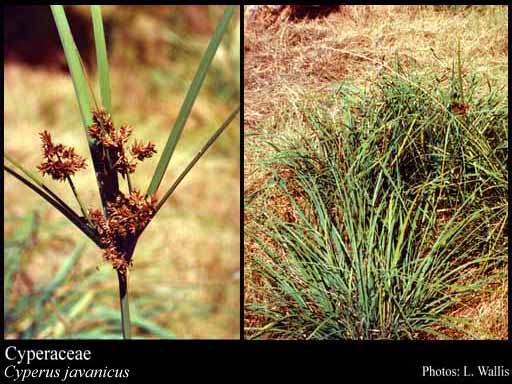- Reference
- Gen.Pl. [Jussieu] 26 (1789)
- Name Status
- Current

Scientific Description
Common name. Sedge Family.
Habit and leaf form. Herbs. ‘Normal’ plants, or switch-plants (sometimes elaminate); sometimes with the principal photosynthesizing function transferred to stems. Annual, or biennial, or perennial; plants with a basal concentration of leaves (usually), or with neither basal nor terminal concentrations of leaves. Young stems triangular in section (commonly), or cylindrical, or oval in section, or flattened; not breaking easily at the nodes. Stem internodes solid, or hollow (uncommonly). To (0.005–)0.05–3(–5) m high; rhizomatous, or tuberous. Hydrophytic, or helophytic, or mesophytic, or xerophytic (rarely, e.g. Caustis); when hydrophytic, free floating, or rooted. Leaves of aquatics submerged and emergent; alternate; spiral (rarely), or distichous (often), or tristichous (usually); sessile, or petiolate (occasionally); sheathing. Leaf sheaths with joined margins (usually), or with free margins. Leaves simple. Leaf blades entire; flat, or folded (and occasionally plicate), or rolled, or solid; setaceous, or acicular, or linear to obovate; parallel-veined; cross-venulate, or without cross-venules. Leaves ligulate (commonly), or eligulate. Leaf blade margins usually entire (but commonly with prickle hairs); flat, or revolute, or involute. Prophylls 1. Leaves with a persistent basal meristem, and basipetal development. Vernation conduplicate, or plicate, or involute, or revolute, or convolute. Vegetative anatomy. Plants with silica bodies (usually). Leaf anatomy. Leaf blade epidermis without differentiation into ‘long’ and ‘short’ cells. Stem anatomy. Secondary thickening absent (with compound vascular bundles in Gahnia).
Reproductive type, pollination. Fertile flowers hermaphrodite, or functionally male and functionally female, or functionally male, or functionally female, or hermaphrodite, functionally male, and functionally female (etc.). Unisexual flowers present, or absent. Plants hermaphrodite, or monoecious, or andromonoecious, or gynomonoecious, or dioecious, or androdioecious, or gynodioecious. Floral nectaries absent (nectaries lacking). Anemophilous (mostly), or entomophilous (occasionally, associated with white or coloured bracts or upper leaves).
Inflorescence and flower features. Flowers aggregated in ‘inflorescences’; in ‘spikelets’. The terminal inflorescence unit cymose, or racemose (the flowers solitary, or 1–50 in ‘spikelets’). Inflorescences with the spikelets often numerous, in branched, paniculate inflorescences. Flowers bracteate, or ebracteate; bracteolate (each borne in the axil of a ‘glume’); usually small, or minute. Perigone tube absent. Hypogynous disk absent (usually), or present (in a few genera). Perianth of ‘tepals’, or vestigial (represented by bristles or hairs), or absent; when present, often 6; sometimes more or less sepaloid. Fertile stamens present, or absent (when female). Androecium 1–3, or 4–6(–22). Androecial members free of the perianth; free of one another (usually), or coherent (connate filaments in some Carex species). Androecium exclusively of fertile stamens. Stamens 1–3, or 4–6(–22). Anthers basifixed; introrse, or latrorse; tetrasporangiate; appendaged (via prolongation of the connective into an apiculus), or unappendaged. Pollen shed in aggregates (though ostensibly solitary, as pseudomonads); in tetrads (with three members degenerated). Fertile gynoecium present, or absent (when male). Gynoecium 2 carpelled, or 3(–4) carpelled. The pistil 1 celled. Gynoecium syncarpous; synovarious to synstylovarious; superior. Ovary unilocular; 1 locular. Styles 2–3; free to partially joined. Stigmas (1–)2, or 3(–15); dry type; papillate, or non-papillate; Group II type (IIA and IIB). Placentation basal. Ovules in the single cavity 1; non-arillate; anatropous.
Fruit and seed features. Fruit non-fleshy; indehiscent; achene-like, or a drupe (very rarely). Seeds endospermic. Endosperm not oily (mealy or fleshy, usually), or oily (rarely). Seeds usually with starch. Embryo well differentiated, or rudimentary at the time of seed release (Rhynchosporoideae). Cotyledons when detectable, 1. Embryo achlorophyllous (doubtfully — 2/2). Testa without phytomelan. Seedling. Hypocotyl internode absent. Mesocotyl present, or absent. Seedling collar not conspicuous. Cotyledon hyperphyll compact; non-assimilatory. Coleoptile present. Seedling cataphylls absent. First leaf dorsiventral. Primary root ephemeral.
Physiology, biochemistry. Aluminium accumulation demonstrated. Photosynthetic pathway: C3 and C4, or C3-C4 intermediate.
Geography, cytology, number of species. Holarctic, Paleotropical, Neotropical, Cape, Australian, and Antarctic. World distribution: cosmopolitan, predominating in moist habitats. About 5000 species.
Economic uses, etc. Some noxious weeds, otherwise of little economic importance — Cyperus papyrus is of historical interest in connection with papermaking, and that genus furnishes a few watergarden ornamentals; Cyperus esculentus has edible rhizomes.